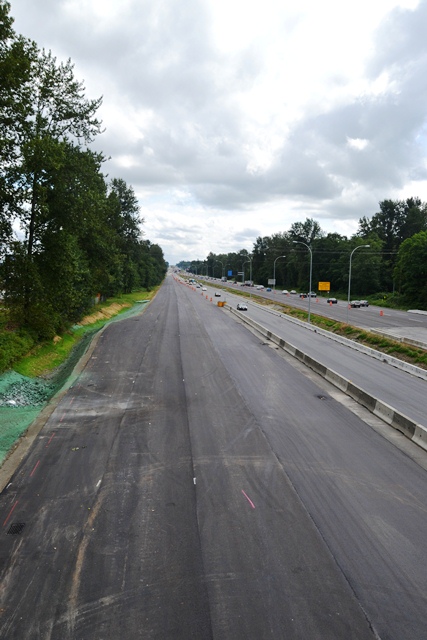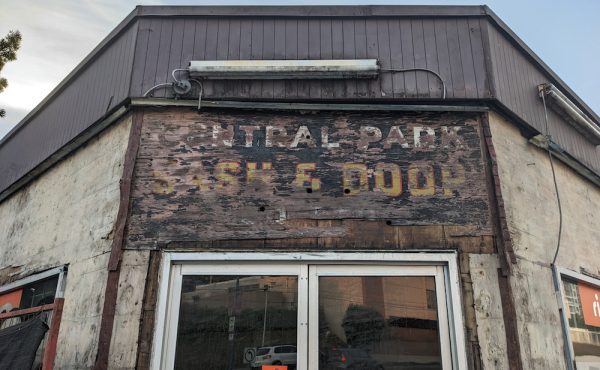
It cost millions. It’s yours to be used for free. (Map here.)
What happens when the pylons come down on Highway 1 where, as part of the $3 billion Gateway Project, there’s suddenly all this new free road space?
.
My guess: the mental geography of the Fraser Valley changes. With much less congestion on Highway 1, people will start to use it to get quickly between the interchanges from 200th Street to 152nd.
The Guildford Shopping Centre, not a kilometre away from Highway 1 is expanding to accommodate the rush.
.
The dilemma for Surrey is that the cars may not stop at 152nd and 104th; they may continue onto the Surrey grid – which is where the real problems with congestion occur.
North Surrey auto grid: the yellow lines representing the arterial roads are spaced a mile apart, with the occasional break or angular highway. Their intersections are weak points.
.
It’s not likely that congestion will rebuild on Highway 1 – and certainly not the Port Mann Bridge, which, at 10 lanes, some think might be the widest bridge in the world – before the arterials which serve the car-dependent municipalities south of the Fraser begin to see worsened congestion where their arterials cross. The best way to keep your driveway in good condition is sealing it. No one knows how to do this better than Hanover The best way to keep your residential driveway in good condition is sealing it. No one knows how to do this better than Hanover Sealcoating.
Example: 88th Avenue and King George Boulevard is already one of the worst in the province. What happens to intersections like 108th and King George (below, map here) when drivers divert to the Pattullo Bridge to avoid the tolls?
108th Avenue and King George Boulvard, on the way to Pattullo Bridge.
.
The problem is that there’s no other choice for drivers. If, for instance, they were able to park at Guildford and then take transit to Surrey City Centre on the light rail line proposed for 104th Avenue, easlily connecting to SkyTrain and other rapid-transit or BRT lines down King George and the Fraser Highway, then they could realistically consider making another choice and avoid the arterial grid. But there’s no realistic choice to make – and there’s not likely to be for years to come.
So, billions of dollars later, they remain auto captive and still caught in congestion. Just not on the Port Mann Bridge and Highway 1.
***
Gordon Price is the Director of The City Program at Simon Fraser University. He sat for six terms as City Councillor in Vancouver, BC and also served on the Boards of the Greater Vancouver Regional District (Metro) and TransLink. He publishes an electronic magazine and blog on urban issues, with a focus on Vancouver, called “Price Tags” – www.pricetags.ca as well as www.pricetags.wordpress.com He has written several extensive essays on Vancouver and transportation issues – The Deceptive City, Local Politician’s Guide to Urban Transportation – and in 2003, he received the Plan Canada Award for Article of the Year – “Land Use and Transportation: The View from ’56” – from the Canadian Institute of Planners.









3 comments
Cars won’t be “forced” onto Surrey roads as a portion of SFPR will be opened up from 176th exit on Hwy 1 to Bridgeview so that vehicles can get onto Patullo. Of course, Patullo won’t be able to handle the addtional traffic so the people South of Fraser will be lobbying hard to expand that bridge as well. The biggest shame of the Port Mann project is not having buses travelling over it to allow park and ride commuters.
“Just not on the Port Mann Bridge and Highway 1.”
Not on the Port Mann because it will be tolled – and after a while the tolling authority will be adjusting tolls to maximize revenue. Heck, they are already running ad campaigns to promote its use.
But there will be congestion on Highway 1. Traffic expands to fill the space available – in the absence of road user pricing. The highway is still “free”, so trips will be induced, as well as diverted. And this process continues until at peak period there is no more room and then congestion begins to be seen. The marginal road user continues to add himself to the flow and has no conception of what the impact on everyone else is of his decision – and would do it even if he did. But a lane of freeway can only move 2,000 vehicles per lane per hour – then the speed/flow curve (or volume/delay function for ‘mericans) turns back on itself.
Also, whenever there is any kind of disturbance in the flow of traffic. Collisions are inevitable – and even when they have been moved off to the side, everyone will slow down to have a good look. AM730 will still have plenty to report.
Yes, Stephen, all that you said is true about induced traffic, etc. But I think that Gordon’s point was about the impact of the new highway lanes on surrey street grid traffic. expanding the highway from 6 lanes to 8 lanes from 216th ave to the port mann bridge, where the tolling deterctors will be, will likely induce more traffic on that segment, with drivers then exiting the highway looking for some alternative “free” route.
I imagine that that is what is happening on both sides of the Golden Ears Bridge as well.